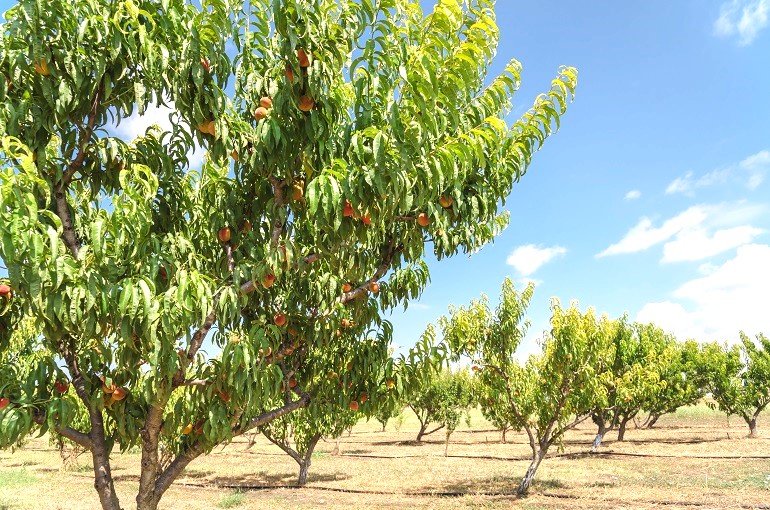Irrigating Peach Trees – How much Water do Peach Trees need?

This post is also available in:
This post is also available in:
![]() Español (Spanish)
Español (Spanish) ![]() Français (French)
Français (French) ![]() Deutsch (German)
Deutsch (German) ![]() हिन्दी (Hindi)
हिन्दी (Hindi) ![]() 简体中文 (Chinese (Simplified))
简体中文 (Chinese (Simplified)) ![]() Ελληνικά (Greek)
Ελληνικά (Greek) ![]() Português (Portuguese (Brazil))
Português (Portuguese (Brazil))
Peach Water Requirements
Irrigation is one of the most critical operations and is essential to the success of a peach orchard (good vegetative growth, high yields, and quality fruits). In general, low soil moisture is highly associated with the inhibition of vegetation growth and decreased production. On average, a peach tree requires around 30 inches of water (760 mm from rainfalls or irrigation) annually. Similarly, a peach orchard needs about 5,000-6,000 ㎥ per hectare (2,000-2,400 ㎥ per acre). The amount may vary depending on the soil type, age of trees, and plant density.
The goal is to help the soil maintain adequate moisture, making it available for the trees at any time during the growing season. The water needs of peach trees peak during the endocarp hardening stage of the fruit and until the fruit maturing stage. These stages usually occur from spring to summer. Pausing irrigation 45 days after bloom until six weeks before harvest has been proven beneficial in some cases. Moreover, irrigation right after harvesting helps early varieties to differentiate their buds. In well-established, mature peach orchards, the growers usually apply irrigation once a week or every 2-3 weeks. In periods with high water needs, the water application may become more frequent (one session every three days). In the case of a recently planted orchard, the farmer needs to irrigate immediately after planting (to help the soil settle) and continue with one application per week for around 1.5 months to help the tree establishment. For mature trees, less frequent but more prolonged irrigations give better results allowing water to penetrate throughout the root zone of the trees (deep soak).
The goal is to maintain adequate moisture to a depth of 18-24 inches (46 – 60 cm). As a result, irrigation should be applied when soil moisture reaches 50% of the water field’s capacity. However, over-irrigation should be avoided as it often leads to root rot, slow down root growth, and increase the risk of nutrient leaching (mainly nitrogen, boron, and sulfur) and deficiencies (e.g., iron). Tensiometers could be helpful tools for planning a suitable irrigation schedule for a peach orchard.
How to irrigate a peach orchard
In sizeable commercial Peach orchards in the United States, producers use drip irrigation (and trickle systems) and micro jet systems. The growers should avoid wetting the tree canopy to reduce the risk of disease outbreaks and spread. Either of the two irrigation systems allows more precise soil moisture monitoring. More specifically, if a farmer uses a drip irrigation system, he/she can apply fertigation (supply of fertilizers with the irrigation water). A standard drip irrigation system consists of 2 laterals lines per row of a maximum length of 250-300 feet or 76-91 m (to keep good water pressure-supply), whereas the distance between drippers is 1-4 feet (30-120 cm) and 1-6 feet (0.30-1.8 m) away from the tree trunk.
In smaller or home peach orchards, growers may also apply a layer of mulch (3-6 inches or 7.50 – 15 cm thick) 3 feet around the trunk of the tree to maintain soil moisture and as a weed control measure.
Tip: Water requirements can be different under different weather and soil conditions. For example, heavy clay soils usually need less irrigation than sandy soil. Moreover, the trees may not require watering on rainy days or days with high humidity and during dormancy. On the other hand, dry days with high temperatures may require more irrigation sessions. Different varieties may also have different water requirements.
References
- https://extension.usu.edu/yardandgarden/research/peaches-in-the-garden
- https://digitalcommons.usu.edu/cgi/viewcontent.cgi?article=1646&context=extension_curall
- https://extension.okstate.edu/fact-sheets/planting-and-early-care-of-the-peach-orchard.html#cultivars
- https://anrcatalog.ucanr.edu/pdf/8048.pdf
- https://ext.vt.edu/content/dam/pubs_ext_vt_edu/422/422-019/SPES-232.pdf
Peaches Facts, Uses, Nutritional Value and Health Benefits
Peach Tree Information, Variety Selection, and Environmental Requirements
How to Grow Peaches from Seed (Stone)
Growing Peach Trees for Profit – Peach Farming Guide
Peach Tree Soil Requirements, Soil Preparation, and Planting
Propagation and Pollination of Peach trees
How to Train and Prune Peach Trees
Irrigating Peach Trees – How much Water do Peach Trees need?
Peach Tree Fertilizer Requirements








































































